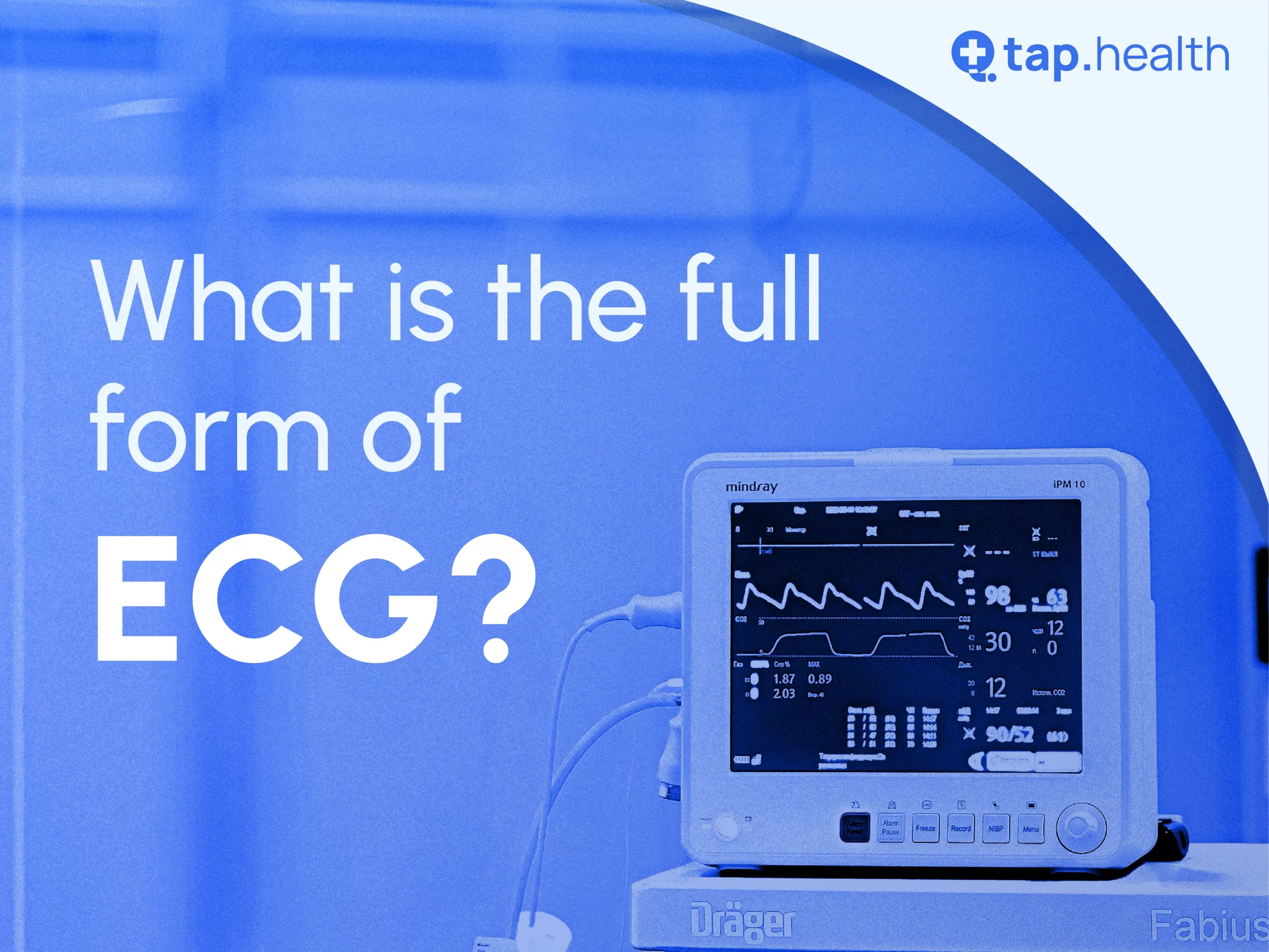ECG full form Electrocardiogram (ECG) is a widely used medical test that records the electrical activity of the heart. It is a non-invasive procedure that provides valuable information about the heart’s rhythm and function. Understanding the basics of ECG is essential for both healthcare professionals and individuals seeking to enhance their knowledge of cardiology.
Understanding the Basics of ECG
ECG stands for Electrocardiogram, which is a diagnostic tool used to assess the electrical activity of the heart. It involves the placement of electrodes on the skin, which detect and record the electrical signals produced by cardiac muscle contraction and relaxation. An electrocardiogram converts heart signals into a graphical representation.
ECG
During an ECG, electrodes are strategically placed on the chest, arms, and legs of the patient to capture the electrical impulses traveling through the heart. The resulting electrocardiogram provides healthcare providers with important information about the heart’s rhythm, rate, and overall electrical activity. By analyzing the patterns and intervals on the ECG tracing, medical professionals can detect irregularities that may indicate underlying heart conditions.
The Importance of ECG in Medical Science
ECG plays a crucial role in diagnosing various cardiac conditions, helping healthcare professionals identify abnormalities in heart rhythm, detect ischemic events, evaluate cardiac medication efficacy, and monitor patients with known heart diseases. It has become an indispensable tool in the field of cardiology, providing valuable insights into the functioning of the heart.
Moreover, ECG technology has evolved over the years, with advancements such as portable ECG devices and wireless monitoring systems making it easier to perform cardiac assessments outside of traditional clinical settings. These innovations have enabled remote monitoring of patients with chronic heart conditions, allowing for early detection of potential issues and timely intervention. Modern medicine is expected to expand its role in utilizing ECG for enhancing patient care and outcomes as technology continues to improve.
The Components of an ECG
A vital tool used in the diagnosis and monitoring of various heart conditions is Electrocardiography (ECG). It records the electrical activity of the heart over time and presents it in the form of waveforms. Understanding the components of an ECG waveform is crucial for interpreting the heart’s electrical behavior accurately.
The P Wave
The P wave is the initial component of the ECG waveform and signifies the depolarization of the atria. This electrical activation triggers the contraction of the atria, allowing them to push blood into the ventricles. The P wave typically appears as a small, upright deflection on the ECG tracing. Variations in the P wave morphology, such as changes in shape or duration, can provide valuable insights into the conduction pathways within the atria and help in diagnosing conditions like atrial fibrillation.
The QRS Complex
Following the P wave, the QRS complex represents the depolarization of the ventricles. This crucial phase indicates the initiation of ventricular contraction, which is essential for pumping blood to the rest of the body. The QRS complex consists of three distinct waves: the Q wave, the R wave (the tallest wave in the complex), and the S wave. Changes in the QRS complex, such as widening or abnormal wave patterns, can indicate issues with the ventricular conduction system and may point towards conditions like myocardial infarction or ventricular hypertrophy.
The T Wave
Completing the ECG cycle, the T wave represents the repolarization of the ventricles. This phase marks the recovery of the ventricles as they prepare for the next contraction. The T wave is typically a modest, dome-shaped wave following the QRS complex. Alterations in the T wave, such as inversion or prolonged duration, can be indicative of various cardiac abnormalities, including ischemia, electrolyte imbalances, or certain medications’ side effects.
How Does an ECG Work?
An electrocardiogram (ECG) is a non-invasive medical test that records the electrical activity of the heart over a period of time. This tool is valuable for detecting and diagnosing various heart conditions, including arrhythmias, heart attacks, and abnormalities in the heart’s structure. Understanding how an ECG works is essential for healthcare professionals to interpret the results accurately and provide appropriate treatment.
The Process of Recording an ECG
Recording an ECG involves placing electrodes on the skin at specific locations, typically on the chest, arms, and legs. These electrodes detect the electrical signals generated by the heart and transmit them to an ECG machine. The machine then amplifies and filters the signals to produce a visual representation on paper or a computer screen. Snacking is crucial for dengue patients to maintain nutrient intake.
Interpreting ECG Results
Analyzing ECGs needs understanding normal patterns and detecting abnormalities accurately. Healthcare professionals analyze the duration, amplitude, and configuration of various ECG components to diagnose cardiac abnormalities accurately. We assess factors such as heart rate, PR interval, and QT interval to determine the presence of arrhythmias and other conditions. In addition to identifying abnormalities, ECG results can also provide valuable information about the heart’s overall health, such as the presence of ischemia or the effects of medication on cardiac function.
Common Conditions Detected by ECG
An electrocardiogram (ECG) is a valuable tool used in the medical field to detect various heart conditions. By analyzing the electrical activity of the heart, healthcare professionals can identify abnormalities that may indicate underlying issues. Analyzing ECGs needs understanding normal patterns and detecting abnormalities accurately.
Arrhythmias and ECG
Arrhythmias are irregular heart rhythms that can range from harmless to life-threatening. The atria produce fast, irregular electrical signals in atrial fibrillation. Ventricular tachycardia involves fast heartbeats originating in the heart’s lower chambers, while bradycardia is a slower than normal heart rate. ECG waveform analysis is crucial in diagnosing these arrhythmias and guiding treatment decisions.
Heart Attacks and ECG
When it comes to heart attacks, time is of the essence. An ECG can quickly identify signs of myocardial infarction by detecting specific changes in the heart’s electrical pattern. ST segment elevation or depression on the ECG tracing indicates potential damage to the heart muscle due to reduced blood flow. Prompt recognition of these ECG findings is essential for initiating interventions such as clot-dissolving medications or emergency procedures like angioplasty to restore blood flow to the heart.
Preparing for an ECG Test
What to Expect During an ECG
During an ECG test, you will have electrodes placed on your skin, typically on your chest, arms, and legs. These electrodes are essential for capturing the electrical signals produced by your heart. Electrodes strategically placed for comprehensive view of heart activity angles. This multi-lead approach helps in detecting any irregularities or abnormalities in the heart’s rhythm.
You must remain still and relax to avoid signal interference. It is crucial to remain as calm as possible to ensure the accuracy of the results. Any movement or muscle tension can create artifacts on the ECG tracings, which may lead to misinterpretation. Quick, painless process takes minutes; non-invasive diagnostic test.
Tips for a Successful ECG Test
An Electrocardiogram (ECG) is a simple and non-invasive procedure that provides critical insights into the electrical activity of your heart. It’s an essential test to diagnose heart conditions like arrhythmias, heart attacks, and heart disease. While the test itself is straightforward, there are a few tips and steps you can take to ensure that the ECG is as accurate as possible and goes smoothly. Here are some helpful tips for a successful ECG test.
1. Wear Comfortable Clothing
Since the ECG test involves the placement of electrodes on your chest, arms, and legs, it’s best to wear loose-fitting clothing that will make it easy for the technician to access these areas. Wearing a top that allows you to remove your shirt or expose your chest easily will help speed up the process.
2. Avoid Applying Lotions or Oils
Before your ECG test, it’s recommended that you avoid applying any lotions, oils, or creams to your chest or the areas where the electrodes will be placed. These substances can interfere with the electrode’s ability to adhere to your skin properly, leading to inaccurate readings.
3. Avoid Caffeine and Stimulants
Caffeine and stimulants like energy drinks or certain medications can affect your heart rate and rhythm, leading to irregular readings. It’s a good idea to avoid consuming caffeine at least 4-6 hours before the test to ensure your heart is in its natural resting state during the procedure.
4. Refrain from Smoking
Smoking can elevate your heart rate and blood pressure, which might cause irregularities in the ECG results. For the best outcome, try to avoid smoking for at least a few hours before the test.
5. Be Prepared for a Relaxed State
For the most accurate ECG results, you should be calm and relaxed during the procedure. Try to avoid any physical exertion before the test. The technician will ask you to lie down and remain still while the test is being conducted. It’s also important to keep your breathing steady and avoid talking during the procedure.
6. Avoid Heavy Meals
Having a large meal just before the ECG test may make you feel uncomfortable, which could affect your ability to remain still during the procedure. To ensure your comfort and get the most accurate readings, it’s recommended to avoid heavy meals for 2-3 hours before the test.
7. Inform the Technician of Any Medical Conditions
Be sure to tell the technician about any existing medical conditions, medications you’re taking, or symptoms you may have been experiencing. Certain conditions, like high blood pressure or electrolyte imbalances, may affect the test results. Letting the technician know beforehand can help them interpret the ECG more accurately.
8. Tell the Technician if You’re Pregnant
While an ECG is generally safe for pregnant women, it’s important to inform the technician if you’re pregnant so they can take any necessary precautions, especially if you’re in your first trimester. The electrodes are placed on the skin, but it’s still a good idea to discuss your pregnancy with your healthcare provider beforehand.
9. Understand What to Expect
Knowing what to expect during the ECG can reduce any anxiety or concerns you may have. The procedure is painless and non-invasive. You will be asked to lie down, and the technician will place small electrodes on your chest, arms, and legs. These electrodes will detect the electrical impulses generated by your heart. The procedure usually takes about 5–10 minutes. You can expect to feel only the mild sensation of the electrodes being applied to your skin.
10. Stay Still During the Procedure
Once the electrodes are placed, it’s important to remain still and avoid moving during the test. Any movement, including talking, can interfere with the accuracy of the results. The technician may ask you to breathe normally, but not to hold your breath or make sudden movements.
11. Ask Questions
If you have any concerns or questions about the ECG procedure, feel free to ask the technician or your healthcare provider before or during the test. Understanding why the test is necessary, what it measures, and how the results will be used can help you feel more at ease.
What Happens After the ECG Test?
Once the test is complete, the electrodes will be removed, and the results will be recorded. The information captured by the ECG will be analyzed by your healthcare provider. In some cases, they may discuss the results with you right after the test. However, if further analysis or consultation is needed, the results may be reviewed in more detail during a follow-up appointment.
Common Reasons for an ECG Test
An ECG is typically ordered if you’re experiencing any of the following symptoms or conditions:
- Chest pain or discomfort
- Shortness of breath
- Irregular heartbeats (palpitations)
- Fainting or dizziness
- Risk factors for heart disease, such as high blood pressure or diabetes
- Monitoring ongoing heart conditions
What Can an ECG Reveal?
An ECG provides valuable information about various aspects of heart health, including:
-
Heart Rate and Rhythm: The ECG can detect arrhythmias (irregular heart rhythms), such as atrial fibrillation, ventricular tachycardia, or bradycardia (slow heart rate).
-
Heart Size and Structure: An ECG can show if the heart chambers are enlarged or if there are other structural abnormalities.
-
Signs of a Heart Attack: During a heart attack, the electrical activity in the heart changes. An ECG can reveal whether a heart attack is occurring or if there has been one in the past.
-
Electrolyte Imbalances: High or low levels of key electrolytes like potassium and calcium can cause changes in the ECG, which may be indicative of metabolic issues.
-
Infarctions and Ischemia: An ECG can show signs of ischemia (lack of blood flow to the heart) or previous heart damage.
In conclusion, an electrocardiogram (ECG) is a valuable diagnostic tool that provides essential information about the electrical activity of the heart. Understanding the basics of ECG, including its components and interpretation, is crucial for healthcare professionals and individuals alike. ECG plays a significant role in detecting various cardiac conditions, such as arrhythmias and heart attacks. By preparing adequately for an ECG test and following the healthcare provider’s instructions, individuals can ensure accurate results and contribute to their overall cardiovascular health.
FAQ on Full Form of ECG
1. Is an ECG painful?
No, an ECG is a painless procedure. The electrodes are simply placed on your skin to detect the heart’s electrical activity.
2. How often should I get an ECG?
The frequency of an ECG depends on your health status and risk factors. Individuals with a history of heart disease or those experiencing symptoms like chest pain or irregular heartbeats may need to have ECGs more often.
3. Can an ECG detect all heart problems?
While an ECG is very effective at detecting many heart conditions, it may not detect all problems. For more in-depth analysis, other tests like echocardiograms or stress tests may be recommended.



